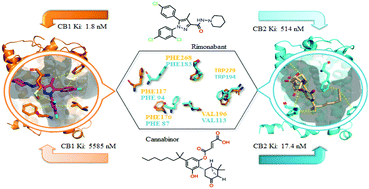A computational prospective on isoform-selective CB2 inhibitors†
Abstract
Cannabinoid (CB) receptors play a vital role in many pathophysiological processes. Selective CB2 activation may lead to the immuno-modulatory effects of cannabinoids being experienced without the psychoactive effects of CB1 activation; however, despite intense efforts, selective and potent CB2 agonists still remain to be developed likely due to the challenges associated with their unexpected CB1 affinity. The aim of this study was therefore to illuminate the selective mechanisms of CB1 and CB2 receptors via analyzing their interaction modes with highly selective ligands. It was found that although CB1 and CB2 exhibit high sequence homology, especially at ligand binding regions, the binding pocket of CB1 is a narrow cross shaped slit that is enclosed by several hydrophobic residues, whereas the binding pocket of CB2 is large and round and therefore would allow for more flexible ligands. In fact, hydrophobic interactions mainly account for the receptor–ligand interactions of both CB1 and CB2, with the key residues that determine the receptor selectivity being MET103, PHE170, VAL196, and PHE268 for CB1, and PHE87, PHE183, PHE94, and TRP194 for CB2. Therefore, the strategy of enlarging the molecular size, increasing hydrogen bond interactions with the key residues of CB2, and furthering the geometric distribution of hydrophobic groups would improve the selectivity towards the CB2 receptor. Collectively, these data shed promising light on elucidating the selective mechanisms between CB1 and CB2, which would lay a solid foundation for the future design of selective inhibitors towards CB2.



 Please wait while we load your content...
Please wait while we load your content...